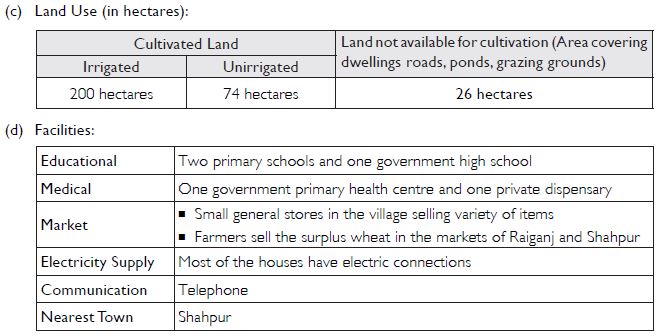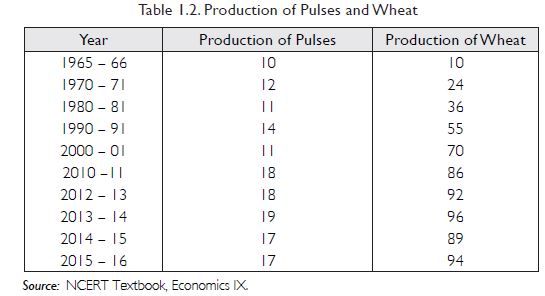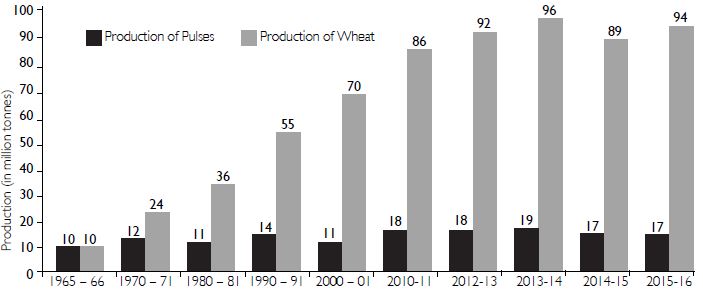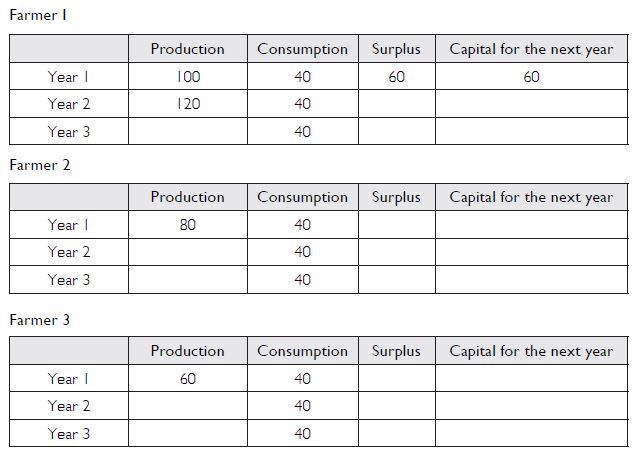Question 1:
Every village in India is surveyed once in ten years during the Census and some of details
are
presented in the following format. Fill up the following, based on information on
Palampur.
(a) Location
(b) Total Area of the Village
(c) Land Use (in hectares)
(d) Facilities
Answer:
Based on information related to Palampur, some of the details are as follows
(a) Location: Western part of Uttar Pradesh
(b) Total Area of the Village: 300 hectares
Question 2:
Modern farming methods require more inputs which are manufactured in industry. Do you agree?
Answer:
Modern farming methods require inputs such as farm machinery, fertilisers, HYV seeds, pesticides, canals, pump sets, diesel, etc., that can be manufactured only in industries.
Question 3:
How did the spread of electricity help farmers in Palampur?
Answer:
The spread of electricity helped farmers in Palampur in the following ways:
(i) Electricity has transformed the system of irrigation. Tubewells are run by electricity
which
irrigate much larger areas of land.
(ii) Farmers bought tools and machinery run by electricity, which speeded up the process of
production.
(iii) Electricity is also used in small scale businesses.
Question 4:
Is it important to increase the area under irrigation. Why?
Answer:
Rain is still the only means of irrigation in many Indian villages. It is important to increase the area under irrigation in order to increase the quantity of production. With the help of modern means of irrigation, even dry regions can be brought under cultivation.
Question 5:
Construct a table on the distribution of land among the 450 families of Palampur.
Answer:
The table below shows the distribution of land among the 450 families of Palampur.
Question 6:
Why are the wages for farm labourers in Palampur less than minimum wages?
Answer:
Most of the farm labourers in Palampur are unskilled. The wages for farm labourers in Palampur are less than the minimum wages because there is heavy competition for work among the farm labourers in Palampur. The supply of labourers is less than their demand. Thus, the landless labourers agree to work at much lower wages than the wages fixed by the government.
Question 7:
What are the different ways of increasing production on the same piece of land? Use examples to explain.
Answer:
The different ways of increasing production on the same piece of land are as follows:
(i) Use of modern irrigation facilities such as canals, pumpsets, dams, etc.
(ii) Use of high quality seeds, fertilisers and pesticides
(iii) Use of modern machinery such as tractors, combines, threshers, drilling machines,
motors, etc.
(iv) Adoption of farming techniques such as multiple cropping.
Question 8:
Describe the work of a farmer with 1 hectare of land.
Answer:
A farmer with 1 hectare of land can work on his own field. He can take help from his family
members.
From the produce, farmers keep sufficient wheat for the family’s consumption and sell the
surplus in
the nearby towns.
Question 9:
How do the medium and large farmers obtain capital for farming? How is it different from the small farmers?
Answer:
Medium and large farmers obtain capital for farming from their own savings or take loans from the banks. Small farmers, on the other hand, do not have sufficient funds. They borrow from large farmers or the village moneylenders or the traders, who supply various inputs for cultivation. The interest on such loans is very high.
Question 10:
On what terms did Savita get a loan from Tajpal Singh? Would Savita’s condition be different if she could get a loan from the bank at a low rate of interest?
Answer:
Savita got a loan of ₹3,000 from Tajpal Singh at an interest rate of 24 per cent for four
months.
Along with such high interest rate, Savita also promised to work on Tajpal Singh’s field as
a farm
labourer during the harvest season, at a very low wage of ₹35 per day.
Savita’s condition could have been different if she could get a loan from the bank. Banks
usually offer
loan to small farmers at a reasonable rate of interest. Moreover, she would not have to work
for the
bank at such low wage rates.
Question 11:
Talk to some old residents in your region and write a short report on the changes in irrigation and changes in production methods during the last 30 years.
Answer:
In the past 30 years, there were no irrigation facilities available in the area. Agriculture was merely a gamble on rain. Good rainy season helped in good production. Methods of production were also traditional. Traditional seeds resulted in low yield. Today, however, with the continuous efforts of the government, people have welcomed the use of various types of modern irrigation methods and HYV techniques such as seeds, chemical fertilisers, pesticides, etc., which has resulted in the increase in production.
Question 12:
What are the non-farm production activities taking place in your region? Make a short list.
Answer:
The various non-farm production activities include:
(i) Dairy and fishing
(ii) Tailoring and shop-keeping
(iii) Transportation activities
(iv) Small manufacturing of tools
(v) Cottage industry
Question 13:
What can be done so that more farm production activities can be started in villages?
Answer:
The following measures can be adopted to encourage more farm production activities in the
villages:
(i) Farmers should be provided capital at cheap rates.
(ii) Village markets should be linked with urban markets through improved transportation
facilities.
(iii) The infrastructure of villages should be improved.
(iv) Farmers should be educated about the latest technology and methods of production on a
regular
basis.
(v) Farmers should be encouraged to diversify and involve in-farm activities such as
forestry, fishing
and horticulture.
Question 14:
The given table shows the land under cultivation in India in units of million hectares. Plot this on the graph provided. What does the graph show?
Is it important to increase the area under irrigation? Why?
Answer:
Yes, it is very important to increase the area under irrigation as it will increase the production to feed the rapidly growing population of India.
Question 15:
What is the difference between multiple cropping and modern farming method?
Answer:
Multiple cropping is the method of growing more than one crop on the same piece of land during different seasons of the year. On the other hand, modern farming methods include the use of tubewells for irrigation, HYV seeds, chemical fertilisers and pesticides in farming. Modern farming methods also include the use of machinery like tractors and threshers.
Question 16:
The following table shows the production of wheat and pulses in India after the Green Revolution in units of million tonnes. Plot this on a graph. Was the Green Revolution equally successful for both the crops? Discuss.
Answer:
The graph below shows the production of pulses and wheat:
Green Revolution was not equally successful for both the crops. While the production of wheat increased significantly, the production of pulses has remained more or less the same.
Question 17:
What is the working capital required by the farmer using modern farming methods?
Answer:
The working capital required by the farmer using modern farming methods includes HYV seeds, chemical fertilisers, diesel, pesticides and insecticides, etc.
Question 18:
Modern farming methods require the farmer to start with more cash than before. Why?
Answer:
Modern farming methods require both working as well as fixed capital. Thus, the farmers require more cash than before to start with farming.
Question 19:
Why do many families of farmers cultivate very small plots of land?
Answer:
Many families of farmers cultivate small plots of land due to the tendency of dividing the large family’s land among sons, brothers and other family members.
Question 20:
The distribution of farmers in India and the amount of land they cultivate is given in the following Graph 1.1. Discuss in the classroom.
Answer:
It is clear from the above graph that in India, 85 per cent of the farmers have less than 2 hectares of land. These farmers cultivate only 44.6 per cent of the total cultivated area. In contrast to this, 15 per cent of the farmers have more than 2 hectare of land and have 55.4 per cent of the total cultivated area. This describes the extent of inequality in the distribution of land in our country.
Question 21:
Would you agree that the distribution of cultivated land is unequal in Palampur? Do you find a similar situation for India? Explain.
Answer:
Yes, the distribution of cultivated land is unequal in Palampur because 240 families in Palampur cultivate less than 2 hectares of land while 60 families cultivate more than 2 hectares. Only a few farmers have 10 or more than 10 hectares of land. We find a similar situation in India as well.
Question 22:
Identify the work being done on the field in Picture 1–6 and arrange them in a proper sequence.
Answer:
The work shown in the given picture is as follows. The sequence of these activities has been
stated
along with.
(i) Cutting of the crops 6
(ii) Ploughing with the bullock 2
(iii) Spraying of insecticides 5
(iv) Sowing the field 4
(v) Cultivation by traditional method 1
(vi) Cultivation by modern method 3
Question 23:
Why are farm labourers like Dala and Ram Kali poor?
Answer:
Farm labourers like Dala and Ram Kali are poor because they could not get work on regular
basis.
Due to competition among labourers, they get wages even less than the minimum wages fixed by
the government.
Question 24:
Gosaipur and Majauli are two villages in North Bihar. Out of a total of 850 households in the two villages, there are more than 250 men who are employed in rural Punjab and Haryana or in Delhi, Mumbai, Surat, Hyderabad or Nagpur. Such migration is common in most villages across India. Why do people migrate? Can you describe (based on your imagination) the work that the migrants of Gosaipur and Majauli might do at the place of destination?
Answer:
People migrate due to the non-availability of proper wage providing work at their native place of living or in search of higher wages. The migrants of Gosaipur and Majauli might do the following work at the place of destination:
- As farm labourers
- Household servants
- Workers in factories
- Helpers at hotels, shops, etc.
- As rickshaw-pullers
- Assist plumbers, electricians, etc.
- Work as carpenters, painters, etc.
Question 25:
We have read about the three factors of production–land, labour and capital and how they are used in farming. Let us fill in the blanks given below:
Answer:
Among the three factors of production, we found that labour is the most abundant factor of
production. There are many people who are willing to work as farm labourers in the villages,
whereas
the opportunities of work are limited. They belong to either landless families or families
cultivating
small plots of land. They are paid low wages and lead a difficult life.
In contrast to labour, land is a scarce factor of production. Cultivated land area is less.
Moreover, even
the existing land is distributed unequally (unequally/equally) among the people engaged in
farming.
There are a large number of small farmers who cultivate small plots of land and live in
conditions not
much better than the landless farm labourer. To make the maximum use of the existing land,
farmers
use multiple cropping and modern farming methods. Both these have led to increase in
production
of crops.
Modern farming methods require a great deal of capital. Small farmers usually need to borrow
money
to arrange for the capital, and are put to great distress to repay the loan. Therefore,
capital too is a
scarce factor of production, particularly for the small farmers.
Though, both land and capital are scarce, there is a basic difference between the two
factors of
production. Land is a natural resource, whereas capital is man-made. It is possible to
increase capital,
whereas land is fixed. Therefore, it is very important that we take good care of land and
other natural
resources used in farming.
Question 26:
Let us take three farmers. Each has grown wheat on his field though the production is
different
(see Column 2). The consumption of wheat by each farmer’s family is the same (see Column 3).
The whole of surplus wheat this year is used as capital for next year’s production. Also
suppose,
production is twice the capital used in production.
(i) Complete the tables.
(ii) Compare the production of wheat by the three farmers over the years.
(iii) What happens to Farmer 3 in Year 3? Can he continue production? What will he have to
do to continue production?
Answer:
(i) Completed tables are as below:
(ii) The production by Farmer 1 kept on increasing day-by-day over the years. Farmer 2, on
the other
hand, remained constant over the years. Also, Farmer 3’s production of wheat is
decreasing.
(iii) In the 3rd year, the farmer does not have any capital to undertake production. In
order to continue
production, the farmer would have to borrow funds. With those funds, Farmer 3 should adopt
modern farming methods, so that he is in a position to produce surplus crop.
Question 27:
What capital did Mishrilal need to set up his jaggery manufacturing unit?
Answer:
Mishrilal needed mechanical sugarcane crushing machines, run on electricity, to set up his jaggery manufacturing unit.
Question 28:
Who provides the labour in this case?
Answer:
Mishrilal and his family members can themselves provide the labour in this case. He can also hire landless labourers.
Question 29:
Can you guess why Mishrilal is unable to increase his profit?
Answer:
Mishrilal is unable to increase his profit because the land allocated for the production of sugarcane is limited in his village.
Question 30:
Could you think of any reasons when he might face a loss?
Answer:
He might face a loss if the demand for jaggery falls. There can also be certain reasons which can cause the production of sugarcane resulting in loss to Mishrilal. These reasons can be:
- Defect in machinery
- Drought or any natural calamity
- Increase in the price of inputs
Question 31:
Why does Mishrilal sell his jaggery to traders in Shahpur and not in his village?
Answer:
Mishrilal sells his jaggery to traders in Shahpur, as the market for jaggery in Shahpur is big in comparison to his village. Hence, he can earn more profit there.
Question 32:
In what ways is Kareem’s capital and labour different from Mishrilal’s?
Answer:
Kareem’s capital is computer while Mishrilal’s capital is mechanical sugarcane crushing
machine.
Kareem’s labour is hired and qualified whereas Mishrilal’s labour is self-employed.
Question 33:
Why didn’t someone start a computer centre earlier? Discuss the possible reasons.
Answer:
The following can be the reasons for not starting a computer centre earlier:
- Lack of demand, due to unawareness about such a course.
- Insufficient faculty to run a computer centre.
Question 34:
What is Kishora’s fixed capital?
Answer:
Kishora’s fixed capital includes a buffalo and a wooden cart.
Question 35:
What do you think would be his working capital?
Answer:
His working capital would be money.
Question 36:
In how many production activities is Kishora involved?
Answer:
Kishora is involved in three production activities:
- Selling milk
- Making clay pots
- Carrying loads of jaggery and other commodities to Shahpur in his wooden cart
Question 37:
Would you say that Kishora has benefited from better roads in Palampur?
Answer:
Due to better roads in Palampur, Kishora can use his wooden cart as a means of transport for carrying loads of jaggery and other commodities to Shahpur. This has helped him increase his income.











